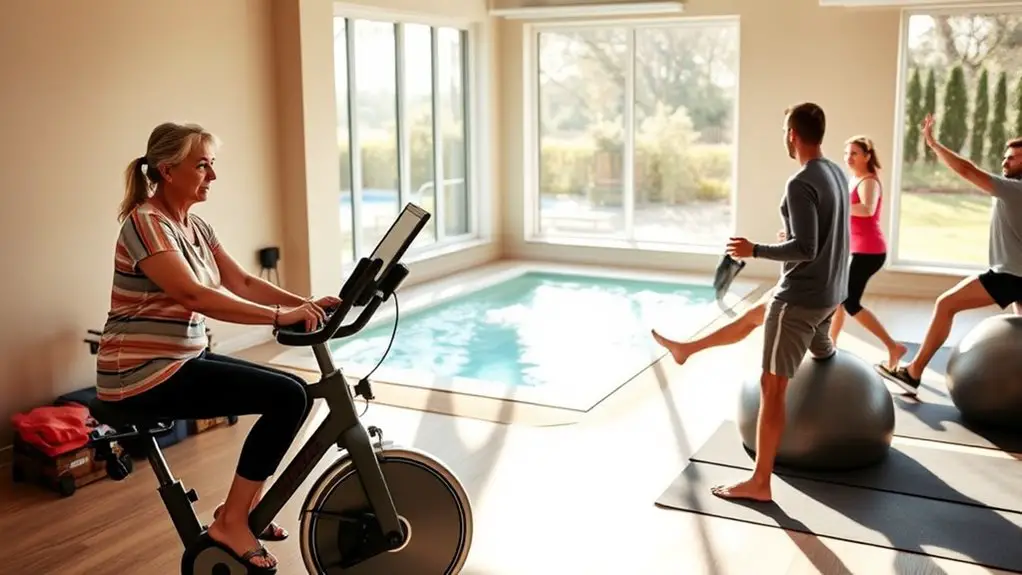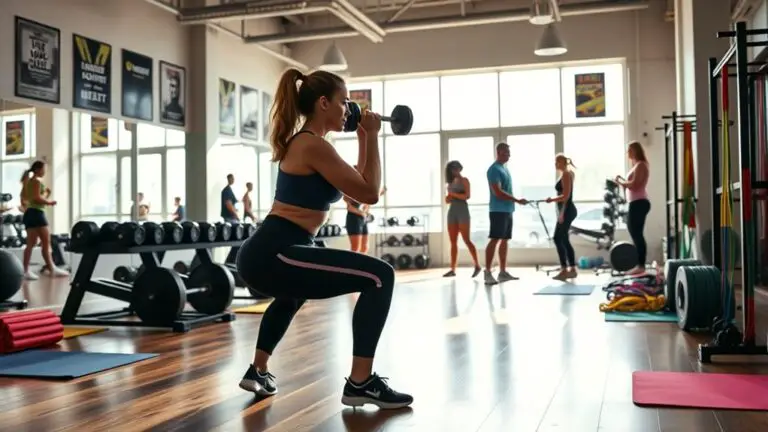Best Cardio Workouts for People With Joint Pain

If you have joint pain, consider low-impact cardio workouts like swimming, cycling, and walking. Swimming provides a full-body workout with minimal strain, while cycling strengthens your heart without discomfort. You can also enjoy walking on softer surfaces or using elliptical machines, which are easier on your joints. Chair exercises offer movement while seated, and dance workouts can keep it fun and engaging. To learn about more options that can benefit your joint health, keep exploring!
Understanding Joint Pain and Its Impact on Exercise

When you experience joint pain, it can greatly affect your ability to exercise and stay active. Joint inflammation often leads to discomfort, making it challenging to engage in physical activities you once enjoyed. This pain can create a cycle of inactivity, which may worsen your condition over time. Understanding the nature of your joint pain is vital for effective pain management.
You might want to consult a healthcare professional to identify the underlying causes of your joint inflammation. They can guide you on safe exercises tailored to your specific needs. Focusing on low-impact activities and incorporating stretching can help alleviate some discomfort while allowing you to maintain a routine. Listening to your body is important; if something doesn’t feel right, it’s best to stop. Prioritizing safety and gradually easing into exercise will help you manage your joint pain while staying active and healthy.
Benefits of Low-Impact Cardio Workouts
Low-impact cardio workouts offer a great way to get your heart pumping without putting extra stress on your joints. You’ll not only reduce the risk of aggravating any existing pain but also improve your overall cardiovascular health. This balance makes low-impact options an ideal choice for anyone looking to stay active while being mindful of their body. Incorporating exercises like skipping rope can strengthen muscles around knees and further enhance joint stability.
Reduced Joint Stress
While high-impact workouts can be tough on your joints, opting for low-impact cardio can markedly reduce joint stress and still deliver great fitness benefits. These workouts are gentle on your body while improving joint mobility and assisting in pain management. Here’s why low-impact cardio is a smart choice:
- Protects your joints from excessive strain
- Enhances flexibility and range of motion
- Boosts endurance without risking injury
- Reduces inflammation and discomfort
- Supports overall physical and mental well-being
Incorporating low-impact cardio into your routine can help you stay active and enjoy exercise safely. Remember, taking care of your joints is essential for a sustainable fitness journey, and low-impact options can provide that balance you’re looking for.
Improved Cardiovascular Health
Engaging in low-impact cardio workouts not only eases pressure on your joints but also greatly boosts your cardiovascular health. These gentle exercises, like swimming or cycling, enhance your heart health by improving blood circulation and lowering blood pressure. You’ll notice an increase in your aerobic capacity, which means your body can utilize oxygen more efficiently during physical activities. This improvement helps you feel more energetic and capable of performing daily tasks with ease. Plus, maintaining a strong cardiovascular system can reduce your risk of heart-related issues in the future. So, by focusing on safe, low-impact workouts, you’re not just protecting your joints; you’re also investing in a healthier heart and a more active lifestyle.
Swimming: A Joint-Friendly Cardio Option

If you’re looking for a cardio workout that’s gentle on your joints, swimming might be the perfect choice for you. The buoyancy of water reduces strain on your body, allowing for effective movement with minimal impact. Plus, water resistance helps build strength while promoting muscle relaxation, making it ideal for those with joint pain.
Here are some benefits of swimming for your cardio routine:
- Provides a full-body workout without stress on joints
- Enhances cardiovascular fitness safely
- Promotes muscle relaxation and flexibility
- Allows for varied intensity levels to match your comfort
- Can be done year-round in pools or open water
Incorporating swimming into your routine can help you stay active while protecting your joints. Just remember to start slow and listen to your body, ensuring a safe and enjoyable experience.
Cycling: Strengthening Your Heart Without the Strain
Cycling offers a fantastic way to boost your cardiovascular health without putting excessive strain on your joints. It’s a low-impact exercise that helps strengthen your heart while minimizing discomfort. Whether you choose a stationary bike or ride outdoors, cycling benefits include improved endurance and enhanced mood.
To guarantee a safe and enjoyable experience, pay attention to bike maintenance. Regularly checking tire pressure, brakes, and the chain can prevent accidents and guarantee smooth rides. Adjusting your bike for the right fit is essential, too; it can greatly reduce joint discomfort and enhance performance.
Start slowly, and gradually increase your distance and intensity to avoid overexertion. Remember to listen to your body—if something doesn’t feel right, don’t hesitate to take a break. With proper care and attention, cycling can be a rewarding way to stay active and support your cardiovascular health without undue strain on your joints.
Walking: The Simplest Form of Cardio

Walking stands out as one of the easiest and most accessible forms of cardio, making it an ideal choice for those dealing with joint pain. By incorporating proper walking techniques, you can enjoy significant walking benefits while minimizing discomfort. Here’s how you can make the most of your walking routine:
- Start with short distances, gradually increasing as you feel comfortable.
- Choose supportive footwear to reduce impact on your joints.
- Maintain a steady, relaxed pace to avoid strain.
- Walk on softer surfaces like grass or dirt paths when possible.
- Incorporate gentle stretches before and after your walk.
These simple adjustments can help enhance your experience, allowing you to reap the rewards of cardiovascular exercise without exacerbating joint pain. Remember, always listen to your body and consult a healthcare professional if you have concerns about your walking routine.
Elliptical Machines: A Safe Alternative for Cardio
If you’re looking for a cardio workout that’s easy on your joints, elliptical machines are a great option. They provide low-impact exercise while allowing you to adjust the resistance to suit your fitness level. This means you can enjoy joint-friendly workouts without sacrificing intensity.
Low-impact Exercise Benefits
While many traditional cardio workouts can strain your joints, elliptical machines offer a safe and effective alternative that minimizes impact. By incorporating low-impact exercises into your routine, you can enjoy several benefits that cater to your safety and wellness:
- Reduced joint stress
- Improved cardiovascular health
- Enhanced muscle strength
- Increased calorie burn
- Adaptability for various fitness levels
Using adaptive equipment like elliptical machines allows you to engage in recovery techniques without risking further injury. They provide a smooth, gliding motion that protects your joints while still delivering an effective workout. So, if you’re looking for a way to stay active without the worry of joint pain, consider adding an elliptical machine to your fitness arsenal. Your body will thank you!
Adjustable Resistance Levels
Adjustable resistance levels on elliptical machines provide a tailored workout experience that caters to your fitness needs and goals. With the ability to modify resistance through adjustable bands, you can gradually increase the intensity of your workout while remaining mindful of your joints. This flexibility makes it easier to engage in safe resistance training without putting undue strain on your body. You can start at a lower resistance to build strength and endurance, then adjust as you progress. By controlling the intensity, you’ll minimize the risk of injury and keep your workouts enjoyable. Incorporating these adjustable features allows you to work out effectively while prioritizing your joint health, making elliptical machines an excellent choice for cardio.
Joint-friendly Workouts
Many people with joint pain find it challenging to engage in traditional cardio workouts, but elliptical machines offer a joint-friendly alternative. These machines provide a low-impact option, reducing strain on your joints while still delivering an effective workout. Here are some benefits of using an elliptical:
- Minimizes impact on knees and hips
- Allows for adjustable resistance levels
- Engages both upper and lower body
- Can be combined with water aerobics for variety
- Pairs well with resistance bands for strength training
Choosing an elliptical machine can help you maintain your fitness without sacrificing safety. Remember, always listen to your body and consult with a healthcare professional before starting a new workout routine to verify it’s suitable for your specific needs.
Chair Exercises: Staying Active While Seated
If you’re dealing with joint pain, chair exercises can be a fantastic way to stay active without putting extra strain on your body. These exercises allow you to engage in movement while seated, reducing the risk of injury. Start with seated stretches to warm up, gently reaching overhead or side to side. This helps improve flexibility and circulation.
Next, incorporate arm exercises. You can use light weights or resistance bands to strengthen your upper body. Simple movements like bicep curls or lateral raises can be done safely from your chair.
Remember to listen to your body; if something doesn’t feel right, adjust or skip that exercise. Consistency is key, so aim to perform these chair exercises several times a week. By staying active in a safe manner, you’ll enhance your overall well-being and manage joint pain more effectively.
Dance Workouts: Fun and Low-Impact
Dance workouts can be a delightful way to stay active while minimizing impact on your joints. With various dance styles, you can enjoy rhythmic movement that keeps you engaged without straining your body. Here are some great options to take into account:
- Zumba: Combines dance and fitness with low-impact routines.
- Ballet: Focuses on fluid movements and posture, great for flexibility.
- Line Dancing: Offers structured steps that are easy to follow.
- Chair Dancing: Allows you to dance while seated, reducing strain.
- Social Dancing: Enjoy a partner dance like the waltz or salsa at your own pace.
These workouts not only promote cardiovascular health but also boost your mood and creativity. Just remember to listen to your body and adjust movements as needed to guarantee safety. So, put on your favorite tunes and have fun while moving!
Yoga and Pilates: Gentle Cardio for Joint Health
While you might think of yoga and Pilates as primarily strength-building practices, they also offer gentle cardio benefits that can support joint health. By incorporating breath control and a flexibility focus, these activities promote circulation without stressing your joints.
| Benefit | Yoga | Pilates |
|---|---|---|
| Breath Control | Enhances relaxation | Improves core strength |
| Flexibility Focus | Increases range of motion | Supports balanced posture |
| Joint Safety | Low-impact movements | Focus on alignment |
Both yoga and Pilates encourage mindful movements, which can reduce the risk of injury. As you practice, listen to your body, and adjust poses when needed. This way, you’ll enjoy the gentle cardio aspects while prioritizing your joint health.
Frequently Asked Questions
Can Joint Pain Worsen With Exercise?
Yes, joint pain can worsen with certain exercises, especially if they’re high-impact or not suited to your condition. You should always listen to your body and choose activities that feel comfortable. However, when done correctly, exercise can have significant benefits, like improving strength and flexibility, which may help alleviate discomfort over time. It’s essential to consult a healthcare professional to tailor a safe exercise plan that meets your needs.
What Are the Signs to Stop Exercising?
When you’re exercising, it’s essential to recognize signs that indicate you should stop. If you experience sharp or persistent pain, that’s a strong pain indicator that something’s wrong. You should also pay attention to swelling, dizziness, or shortness of breath. These symptoms highlight your exercise limitations and can signal potential injury. Always listen to your body; if something feels off, it’s better to take a break and reassess before continuing.
How Often Should I Do Cardio Workouts?
When considering how often you should do cardio workouts, frequency guidelines suggest aiming for at least 150 minutes of moderate-intensity cardio each week. You can break this down into sessions lasting 30 minutes, five days a week. Various cardio types, like walking, swimming, or cycling, can be safer options, especially if you’re mindful of your body’s signals. Always listen to your body, and don’t hesitate to adjust your routine as needed for safety.
Is It Safe to Exercise With Arthritis?
Think of your body as a finely tuned instrument; you want to play it safe. If you have arthritis, it’s essential to choose arthritis-friendly exercises that won’t strain your joints. Low-impact activities, like swimming or cycling, can be great options. Always listen to your body, and don’t hesitate to consult a healthcare professional before starting. They can help you create a routine that keeps you active without risking discomfort or injury.
Should I Consult a Doctor Before Starting a New Workout?
Absolutely, you should consult a doctor before starting a new workout, especially if you have existing health concerns. A pre workout assessment can help identify any potential risks and guarantee you’re choosing the right activities for your body. Following your doctor’s recommendations is essential for safety and effectiveness. They can tailor advice based on your individual needs, making certain you stay healthy while pursuing your fitness goals. Prioritize your safety first!





